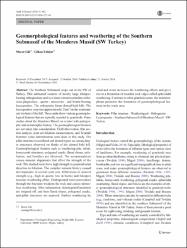| dc.contributor.author | Gül, Murat | |
| dc.contributor.author | Uslular, Göksu | |
| dc.date.accessioned | 2020-11-20T15:02:00Z | |
| dc.date.available | 2020-11-20T15:02:00Z | |
| dc.date.issued | 2016 | |
| dc.identifier.issn | 1866-7511 | |
| dc.identifier.issn | 1866-7538 | |
| dc.identifier.uri | https://doi.org/10.1007/s12517-016-2715-0 | |
| dc.identifier.uri | https://hdl.handle.net/20.500.12809/2339 | |
| dc.description | WOS: 000386689400014 | en_US |
| dc.description.abstract | ' The Southern Submassif crops out in the SW of Turkey. This submassif consists of mostly large feldsparbearing orthogneisses and to a lesser extent tourmaline-orthoclase-plagioclase-, quartz-, muscovite-, and biotite-bearing leucogranites. The orthogneiss forms domed bald hills. The leucogranites crop out (approximately 2 km(2)) in the southeastern lowland of the hill. Those units show various geomorphological features that are typically reported in granitoids. Many studies about the Menderes Massif are related with petrography and metamorphic history. The geomorphological features are not taken into consideration. Field observation, thin section analysis, joint set-foliation measurements, and Schmidt Hammer value determination were done in this study. The pillar structures (castellated and domed types) are among larger structures observed on flanks of the domed bald hill. Geomorphological features such as weathering pits, tafoni, honeycomb structures, polygonal cracks, flared slopes, exfoliation, and boulders are observed. The metamorphism causes mineral alignments that affect the strength of the rock. The studied rocks have high strength in perpendicular direction to foliation. The complex tectonic history caused developments of several joint sets. Differences in mineral strength (e.g., high in quartz, low in biotite and feldspar) increase weathering effect. Underground water percolation through the fractures weakens the rock and causes subsurface weathering. After exhumation, disintegrated materials are stripped off, and then flared slopes, polygonal cracks, and pillar structures are exposed. Surface weathering by wind and water increases the weathering effects and gives rise to a formation of rounded rock edges called spheroidal weathering. Contrary to other granitoid areas, the metamorphism promotes the formation of geomorphological features in the study area. | en_US |
| dc.item-language.iso | eng | en_US |
| dc.publisher | Springer Heidelberg | en_US |
| dc.item-rights | info:eu-repo/semantics/openAccess | en_US |
| dc.subject | Pillar Structure | en_US |
| dc.subject | Weathering Pit | en_US |
| dc.subject | Orthogneiss | en_US |
| dc.subject | Leucogranite | en_US |
| dc.subject | Southern Submassif of Menderes Massif | en_US |
| dc.subject | SW Turkey | en_US |
| dc.title | Geomorphological features and weathering of the Southern Submassif of the Menderes Massif (SW Turkey) | en_US |
| dc.item-type | article | en_US |
| dc.contributor.department | MÜ, Mühendislik Fakültesi, Jeoloji Mühendisliği Bölümü | en_US |
| dc.contributor.authorID | 0000-0001-8485-0093 | |
| dc.contributor.institutionauthor | Gül, Murat | |
| dc.contributor.institutionauthor | Uslular, Göksu | |
| dc.identifier.doi | 10.1007/s12517-016-2715-0 | |
| dc.identifier.volume | 9 | en_US |
| dc.identifier.issue | 16 | en_US |
| dc.relation.journal | Arabian Journal of Geosciences | en_US |
| dc.relation.publicationcategory | Makale - Uluslararası Hakemli Dergi - Kurum Öğretim Elemanı | en_US |


















